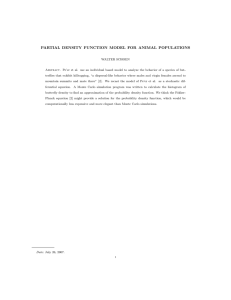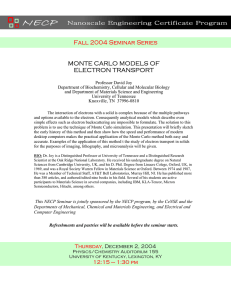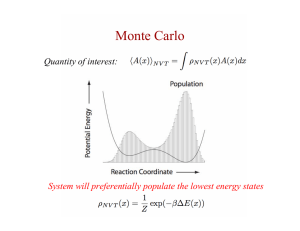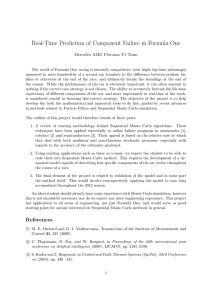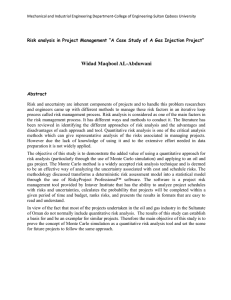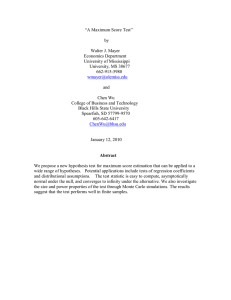Monte Carlo treatment planning for electron beams
advertisement
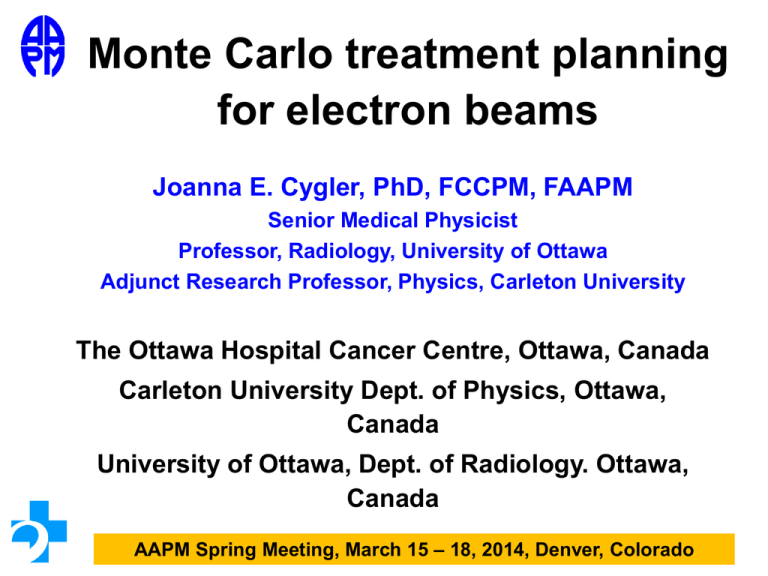
Monte Carlo treatment planning for electron beams Joanna E. Cygler, PhD, FCCPM, FAAPM Senior Medical Physicist Professor, Radiology, University of Ottawa Adjunct Research Professor, Physics, Carleton University The Ottawa Hospital Cancer Centre, Ottawa, Canada Carleton University Dept. of Physics, Ottawa, Canada University of Ottawa, Dept. of Radiology. Ottawa, Canada AAPM Spring Meeting, March 15 – 18, 2014, Denver, Colorado Objectives • To discuss currently available commercial MC-based treatment planning systems for electron beams. • To describe commissioning of such systems in terms of beam models and dose calculation modules. • To discuss the factors associated with MC dose calculation within the patient-specific geometry, such as statistical uncertainties, CT-number to material density assignments, and reporting of dose-to-medium versus dose-to-water. • To discuss possible clinical impact of MC-based electron beam dose calculations Rationale for Monte Carlo dose calculation for electron beams • Difficulties of commercial pencil beam based algorithms – Monitor unit calculations for arbitrary SSD values – large errors* – Dose distributions in heterogeneous media have large errors for complex geometries *can be circumvented by entering separate virtual machines for each SSD – labor consuming Ding, G. X., et al, Int. J. Rad. Onc. Biol. Phys. (2005) 63:622-633 Components of Monte Carlo based dose calculation system There are two basic components of MC dose calculation, see the next slide: 1. 2. Particle transport through the accelerator head – explicit transport (e.g. BEAM code) – accelerator head model (parameterization of primary and scattered beam components) Dose calculation in the patient http://people.physics.carleton.ca/~drogers/egs_windows_collection/sld003.htm courtesy of D.W.O. Rogers Example of a beam model Sub-sources 1 - the main diverging source of electrons and photons; 2 - edge source of electrons; 3 - transmission source of photons; 4 - line source of electrons and photons. M.K. Fix et al, Phys. Med. Biol. 58 (2013) 2841–2859 Commercial implementations • MDS Nordion (NucletronElekta) 2001 – First commercial Monte Carlo treatment planning for electron beams – Kawrakow’s VMC++ Monte Carlo dose calculation algorithm (2000) – Handles electron beams from all clinical linacs • Varian Eclipse eMC 2004 – Neuenschwander’s MMC dose calculation algorithm (1992) – Handles electron beams from Varian linacs only (23EX) – work in progress to include beam models for linacs from other vendors (M.K. Fix et al, Phys. Med. Biol. 58 (2013) 2841–2859) • Elekta-CMS XiO eMC for electron beams 2010 – Based on VMC (Kawrakow, Fippel, Friedrich, 1996) – Handles electron beams from all clinical linacs Nucletron Electron Monte Carlo Dose Calculation Module • Originally released as part of Theraplan Plus • Currently sold as part of Oncentra Master Plan • Fixed applicators with optional, arbitrary inserts, or variable size fields defined by the applicator like DEVA • Calculates absolute dose per monitor unit (Gy/MU) • User can change the number of particle histories used in calculation (in terms of particle #/cm2) 510(k) clearance (June 2002) • Data base of 22 materials • Dose-to-water is calculated in Oncentra • Dose-to-water or dose-to-medium can be calculated in Theraplan Plus MC DCM • Nucletron performs beam modeling Varian Macro Monte Carlo transport model in Eclipse • An implementation of Local-to-Global (LTG) Monte Carlo: – Local: Conventional MC simulations of electron transport performed in well defined local geometries (“kugels” or spheres). • Monte Carlo with EGSnrc Code System - PDF for “kugels” • 5 sphere sizes (0.5-3.0 mm) • 5 materials (air, lung, water, Lucite and solid bone) • 30 incident energy values (0.2-25 MeV) • PDF table look-up for “kugels” This step is performed off-line. – Global: Particle transport through patient modeled as a series of macroscopic steps, each consisting of one local geometry (“kugel”) from C. Zankowski et al “Fast Electron Monte Carlo for Eclipse” Varian Macro Monte Carlo transport model in Eclipse • Global geometry calculations – CT images are pre-processed to user defined calculation grid – HU in CT image are converted to mass density – The maximum sphere radius and material at the center of each voxel is determined • Homogenous areas → large spheres • In/near heterogeneous areas → small spheres from C. Zankowski et al “Fast Electron Monte Carlo for Eclipse” Varian Eclipse Monte Carlo • User can control – Total number of particles per simulation – Required statistical uncertainty – Random number generator seed – Calculation voxel size (several sizes available) – Isodose smoothing on / off • Methods: 2-D Median, 3-D Gaussian • Levels: Low, Medium, Strong • Dose-to-medium is calculated Elekta - CMS XiO Monte Carlo system • XiO eMC module is based on the early VMC* code – simulates electron (or photon) transport through voxelized media • The beam model and electron air scatter functions were developed by CMS • The user can specify – – – – – – voxel size dose-to-medium or dose-to-water random seed total number of particle histories per simulation or the goal Mean Relative Statistical Uncertainty (MRSU) minimum value of dose voxel for MRSU specification • CMS performs the beam modeling *Kawrakow, Fippel, Friedrich, Med. Phys. 23 (1996) 445-457; *Fippel, Med. Phys. 26 (1999) 1466–1475 Clinical implementation of MC treatment planning software • Beam data acquisition and fitting • Software commissioning tests* – Beam model verification – Dose profiles and MU calculations in a homogeneous water tank – In-patient dose calculations • Clinical implementation – procedures for clinical use – possible restrictions – staff training *should include tests specific to Monte Carlo A physicist responsible for TPS implementation should have a thorough understanding of how the system works. User input data for MC based TPS Treatment unit specifications: • Position and thickness of jaw collimators and MLC • For each applicator scraper layer: Thickness Position Shape (perimeter and edge) Composition • For inserts: Thickness Shape Composition No head geometry details required for Eclipse, since at this time it only works for Varian linac configuration User input data for MC TPS cont. Dosimetric data for beam characterization (beam model), as specified in User Manual, for example: • Beam profiles without applicators: – in-air profiles for various field sizes – in-water profiles – central axis depth dose for various field sizes – some lateral profiles • Beam profiles with applicators: – Central axis depth dose and profiles in water – Absolute dose at the calibration point • Dosimetric data for verification – Central axis depth doses and profiles for various field sizes Software commissioning tests: goals • Setting user control parameters in the TPS to achieve optimum results (acceptable statistical noise, accuracy vs. speed of calculations) – Number of particle histories – Required statistical uncertainty – Voxel size – Smoothing • Understand differences between water tank and real patient anatomy based monitor unit values XiO: 9 MeV - Trachea and spine importance of high quality data In high-dose-gradient region sub-millimetre accuracy is required Vandervoort and Cygler, COMP 56th Annual Scientific Meeting, Ottawa, June 2010 0.490 0.850 0.440 0.800 Example of beam model verification CMS eMC: cutout factors 0.390 1 3 5 7 9 1 3 Square Cutout Length (cm) 7 9 Square Cutout Length (cm) Cutout Output Factors: 17 MeV Cutout Output Factors: 9 MeV 1.050 1.050 SSD=100 cm 0.850 0.750 0.650 SSD=115 cm 0.550 Experimental XiO Calculated 0.450 Output Factor (cGy/MU) 1.000 0.950 Output Factor (cGy/MU) 5 0.950 SSD=100 cm 0.900 0.850 0.800 0.750 0.700 SSD=115 cm 0.650 Experimental XiO Calculated 0.600 0.350 1 2 3 4 5 6 Square Cutout Length (cm) 7 8 9 1 2 3 4 5 6 7 Square Cutout Length (cm) Vandervoort and Cygler, COMP 56th Annual Scientific Meeting, Ottawa, June 2010 8 9 Monte Carlo settings: noise in the dose distributions Effect of Mean Relative Statistical Uncertainty (MRSU): 6 MeV beam, 10x10 cm2 applicator, voxel size=2.5×2.5×2.5 mm3, dose-to-medium MRSU=10% Histories=1.2x106 MRSU=10% MRSU=5% Histories=2.8x106 MRSU=5% MRSU=2% Histories=1.6x107 MRSU=2% Eclipse eMC Effect of voxel size and smoothing Ding, G X., et al (2006). Phys. Med. Biol. 51 (2006) , 2781-2799. Dose-to-water vs. dose-to-medium Small volume of water Voxel of medium Dm - energy absorbed in a medium voxel divided by the mass of the medium element. Dw - energy absorbed in a small cavity of water divided by the mass of that cavity. w S Dw Dm m Ding, G X., et al Phys. Med. Biol. 51 (2006), 2781-2799. Dose-to-water vs. Dose-to-medium 6 MeV beam, 15x15 cm2 applicator, both 602 MU MRSU=2%, voxel size=4×4×4 mm3 DTM DTW DTW-DTM MU - MC vs. hand calculations Monte Carlo Hand calculations Real physical dose calculated on a patient anatomy Rectangular water tank Heterogeneity correction included No inhomogeneity correction Arbitrary beam angle Perpendicular beam incidence only 9 MeV, full scatter phantom (water tank) RDR=1 cGy/MU 100% isodose at the nominal (reference) dmax depth Lateral scatter missing Real contour / Water tank = =234MU / 200MU=1.17 Reason for more MU: % isodose at the nominal (reference) dmax depth is less than 100% MU real patient vs.water tank MC / Water tank= 292 / 256=1.14 Internal mammary nodes MC / Water tank= 210 / 206=1.019 MU-real patient vs. water tank: Impact on DVH Posterior cervical lymph node irradiation - impact on DVH MU eMC vs. pencil beam Zhang, A., (2013), J. .Appl. Clin. Med. Phys., 14, (2), 127-145 How long does it take? • MC gives entire dose distribution in the irradiated volume, not just a few points • time for N beams is the same as for 1 beam • timing is a complex question since it depends on – statistical uncertainty and how it is defined – voxel size – field size – beam energy and whether photons or electron – speed of CPU and optimization of compiler - complexity of patient specific beam modifiers Monte-Carlo Settings: Effect on computation time 30 Timing Results XiO TPS: y = 6.4x-2.1 25 9 MeV 2.5 mm voxel time / min 17 MeV 2.5 mm voxel 20 For 9 and 17 MeV beams, 10x10 17 MeV 5 mm voxel -2.0 y = 3.4x 15 cm2 applicator and the trachea 9MeV 5 mm voxel and spine phantom, timing tests were performed for a clinical XiO 10 Linux workstation, which employs y = 0.7x-2.0 5 8 processors, 3 GHz each, with -2.0 0 y = 0.4x 0 8.29 GB of RAM. 0.5 1 1.5 2 2.5 MRSU % Cygler, J.E., and Ding, G.X., in Monte Carlo Techniques in Radiation Therapy, ISBN-10: 1466507926, Taylor & Francis (CRC Press INC ) Boca Raton 2013, p 155-166 Timing – Nucletron TPS Oncentra 4.0 Anatomy - 201 CT slices Voxels 3 mm3 10x10 cm2 applicator 50k histories/cm2 4 MeV Timer Results: Init = 0.321443 seconds Calc = 42.188 seconds Fini = 0.00158201 seconds Sum = 42.5111 seconds 20 MeV Timer Results: Init = 0.311014 seconds Calc = 110.492 seconds Fini = 0.00122603 seconds Sum = 110.805 seconds Faster than pencil beam! Timing – Varian Eclipse Eclipse MMC, Varian single CPU Pentium IV XEON, 2.4 GHz 10x10 cm2, applicator, water phantom, cubic voxels of 5.0 mm sides 6, 12, 18 MeV electrons, 3, 4, 4 minutes, respectively Chetty et al.: AAPM Task Group Report No. 105: Monte Carlo-based treatment planning, Med. Phys. 34, 4818-4853, 2007 Summary • Commercial MC based TP systems are available – fairly easy to implement and use – MC specific testing required • Fast (minutes) and accurate 3-D dose calculations • Single virtual machine for all SSDs • Large impact on clinical practice – Accuracy of dose calculation improved – More attention to technical issues needed – Dose-to-medium is calculated, although some systems calculate dose-to-water as well – MU based on real patient anatomy (including contour irregularities and tissue heterogeneities) • Requirement for well educated physics staff Selected references 1. 2. 3. 4. 5. Kawrakow, I., M. Fippel, and K. Friedrich. (1996), 3D electron dose calculation using a Voxel based Monte Carlo algorithm (VMC), Med Phys 23 (4):445-57. Kawrakow, I., VMC++ electron and photon Monte Carlo calculations optimized for radiation treatment planning, Proceedings of the Monte Carlo 2000 Meeting, (Springer, Berlin, 2001) pp229-236. Neuenschwander H and Born E J 1992 A Macro Monte Carlo method for electron beam dose calculations, Phys. Med. Biol. 37 107 – 125. Neuenschwander H, Mackie T R and Reckwerdt P J 1995 MMC—a highperformance Monte Carlo code for electron beam treatment planning, Phys. Med. Biol. 40 543–74. Janssen, J. J., E. W. Korevaar, L. J. van Battum, P. R. Storchi, and H. Huizenga. (2001). “A model to determine the initial phase-space of a clinical electron beam from measured beam data.” Phys Med Biol 46:269–286. Selected references cont. 6. 7 8 9. Traneus, E., A. Ahnesjö, M. Åsell.(2001) “Application and Verification of a Coupled Multi-Source Electron Beam Model for Monte Carlo Based Treatment Planning,” Radiotherapy and Oncology, 61, Suppl.1, S102. Cygler, J. E., G. M. Daskalov, and G. H. Chan, G.X. Ding. (2004). “Evaluation of the first commercial Monte Carlo dose calculation engine for electron beam treatment planning.” Med Phys 31:142-153. Ding, G. X., D. M. Duggan, C. W. Coffey, P. Shokrani, and J. E. Cygler. (2006). “First Macro Monte Carlo based commercial dose calculation module for electron beam treatment planning-new issues for clinical consideration.” Phys. Med. Biol. 51 (2006) 2781-2799. Popple, RA., Weinberg, R., Antolak, J., (2006) “Comprehensive evaluation of a commercial macro Monte Carlo electron dose calculation implementation using a standard verification data set”. Med Phys 33:1540-1551. Selected references cont. 10. 11. 12. 13. Faddegon, B.A. and Cygler, J.E., Use of Monte Carlo Method in Accelerator Head Simulation and Modelling for Electron Beams, Integrating New Technologies into Clinic: Monte Carlo and Image-Guided Radiation Therapy, AAPM Monograph No. 32, edited by B.H. Curran, J.M. Balter, I.J. Chetty, Medical Physics Publishing (Madison, WI, 2006) P.51-69. Cygler, J.E., Heath, E., Ding, G.X., Seuntjens, J.P., Monte Carlo Systems in Preclinical and Clinical Treatment Planning: Pitfalls and Triumphs, Integrating New Technologies into Clinic: Monte Carlo and Image-Guided Radiation Therapy Monograph No. 32, edited by B.H. Curran, J.M. Balter, I.J. Chetty, Medical Physics Publishing (Madison WI, 2006) p.199-232. Chetty, I., Curran, B., Cygler, J.E., et al.,(2007) Report of the AAPM Task Group No. 105: Issues associated with clinical implementation of Monte Carlo-based photon and electron external beam treatment planning. Med Phys 34, 4818-4853. Reynaert, N., S. C. van der Marck, D. R. Schaart, et al. 2007. Monte Carlo treatment planning for photon and electron beams . Radiat Phys Chem 76: 643–86.. Radiat Phys Chem 76: 643–86. Selected references cont. 14. 15. 16. 17. 18. Fragoso, M., Pillai, S., Solberg, T.D., Chetty, I., (2008) “Experimental verification and clinical implementation of a commercial Monte Carlo electron beam dose calculation algorithm”. Med Phys 35:1028-1038. Edimo, P., et al., (2009) Evaluation of a commercial VMC++ Monte Carlo based treatment planning system for electron beams using EGSnrc/BEAMnrc simulations and measurements. Phys Med, 25(3): 111-21. Cygler, J.E., and Ding, G.X., “Electrons: Clinical Considerations and Applications “ in Monte Carlo Techniques in Radiation Therapy, ISBN-10: 1466507926, Taylor & Francis (CRC Press INC ) Boca Raton 2013, p 155-166 Fix, M. K., Cygler, J. E., Frei, D., Volken, W., Neuenschwander, H., Born, E.J., and Manser, P., (2013), Generalized eMC implementation for Monte Carlo dose calculation of electron beams from different machine types, Phys. Med. Biol. 58, 2841–2859, Zhang, A., Wen, N., Nurushev., T., Burmeister, J., Chetty, I., J., (2013), J. .Appl. Clin. Med. Phys., 14, (2), 127-145 Thank you
